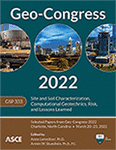DEM Analysis of the Interplay between Soil Density and Earthquake Surface Fault Rupture in Layered Soils
Publication: Geo-Congress 2022
ABSTRACT
Earthquake surface fault rupture produces complex patterns of shear rupture that are heavily influenced by soil inhomogeneity. This study analyzes the influence of inhomogeneous void ratio throughout the soil medium using the distinct element method (DEM). DEM captures the dilatancy and stress–strain response of dense and loose soils without the need for calibration of a constitutive model. Particle assemblages are prepared through a numerical pluviation routine in which loose and dense layers are achieved by pluviating particles with different frictional characteristics. Void ratio is measured within sub-volumes of the particle assemblages. The shear zone along the path of fault rupture is observed as a path of low-relative density and large particle rotations emanating from the bedrock fault. The mobilization of stresses in dense layers exhibited a peak stress followed by softening down to a critical state value, whereas the mobilization of stresses in loose layers monotonically rose to its critical state value. Complex patterns of rupture resulted from the evolution of different soil responses in the layered soil deposit.
Get full access to this article
View all available purchase options and get full access to this chapter.
REFERENCES
Anastasopoulos, I., Gazetas, G., Bransby, M. F., Davies, M. C. R., and El Nahas, A. (2007). “Fault rupture propagation through sand: Finite element analysis and validation through centrifuge experiments.” J. Geotech. Geoenviron. Eng., 133 (8): 943–958.
Anastasopoulos, I., Callerio, A., Bransby, M. F., Davies, M. C. R., El Nahas, A., Faccioli, E., Gazetas, G., Masella, A., Paolucci, R., Pecker, A., and Rossignol, E. (2008). “Numerical analyses of fault–foundation interaction.” Bull. Eq. Eng., 6(4), 645–675.
Anastasopoulos, I., Gazetas, G., Bransby, M. F., Davies, M. C., and El Nahas, A. (2009). “Normal fault rupture interaction with strip foundations.” J. Geotech. Geoenviron. Eng., 135(3), 359–370.
Bray, J. D., Seed, R. B., Cluff, L. S., and Seed, H. B. (1994). “Earthquake fault rupture propagation through soil.” J. Geotech. Eng., 120(3), 543–561, https://doi.org/10.1061/(ASCE)0733-9410(1994)120:3(543).
Bransby, M. F., Davies, M. C. R., and Nahas, A. E. (2008). “Centrifuge modelling of normal fault–foundation interaction.” Bull. Eq. Eng., 6(4), 585–605.
Christoffersen, J., Mehrabadi, M. M., and Nemat-Nasser, S. (1981). “A micromechanical description of granular material behavior.” J. of App. Mech., 48(2), 339–344.
Garcia, F. E., and Bray, J. D. (2018a). “Distinct element simulations of shear rupture in dilatant granular media.” Int. J. Geomech., 18 (9): 04018111, https://doi.org/10.1061/(ASCE)GM.1943-5622.0001238.
Garcia, F. E., and Bray, J. D. (2018). “Distinct element simulations of earthquake fault rupture through materials of varying density.” Soils Found., 58 (4): 986–1000, https://doi.org/10.1016/j.sandf.2018.05.009.
Garcia, F. E., and Bray, J. D. (2019b). “Modeling the shear response of granular materials with discrete element assemblages of sphere-clusters.” Comput. Geotech., 106 (Feb): 99–107, https://doi.org/10.1016/j.compgeo.2018.10.003.
Garcia, F. E., and Bray, J. D. (2019c). “Discrete element analysis of earthquake fault rupture-soil-foundation interaction.” J. Geotech. Geoenviron. Eng., 145 (9): 04019046, https://doi.org/10.1061/(ASCE)GT.1943-5606.0002092.
Garcia, F. E., and Bray, J. D. (2019c). “Discrete-element analysis of the influence of granular soil density on earthquake surface fault rupture interaction with rigid foundations.” J. Geotech. Geoenviron. Eng., 145 (11): 04019093, https://doi.org/10.1061/(ASCE)GT.1943-5606.0002163.
Kloss, C., Goniva, C., Hager, A., Amberger, S., and Pirker, S. (2012). “Models, algorithms and validation for opensource DEM and CFD-DEM.” Prog. Comp. Fluid Dyn. Inter. J., 12 (2/3): 140–152, https://doi.org/10.1504/PCFD.2012.047457.
Lawson, A. C. (1908). “The California earthquake of April 18, 1906: Report of the state earthquake investigation commission…”. Carnegie institution of Washington.
Oettle, N. K., and Bray, J. D. (2016). “Numerical Procedures for Simulating Earthquake Fault Rupture Propagation.” Int. J. of Geomech., 17(1), 04016025, https://doi.org/10.1061/(ASCE)GM.1943-5622.0000661.
Rathje, E., Dawson, C., Padgett, J. E., Pinelli, J.-P., Stanzione, D., Adair, A., Arduino, P., Brandenberg, S. J., Cockerill, T., Dey, C., Esteva, M., Haan, F. L., Jr., Hanlon, M., Kareem, A., Lowes, L., Mock, S., and Mosqueda, G. (2017). “DesignSafe: A New Cyberinfrastructure for Natural Hazards Engineering,” ASCE Natural Hazards Review, https://doi.org/10.1061/(ASCE)NH.1527-6996.0000246.
Information & Authors
Information
Published In
History
Published online: Mar 17, 2022
Authors
Metrics & Citations
Metrics
Citations
Download citation
If you have the appropriate software installed, you can download article citation data to the citation manager of your choice. Simply select your manager software from the list below and click Download.
